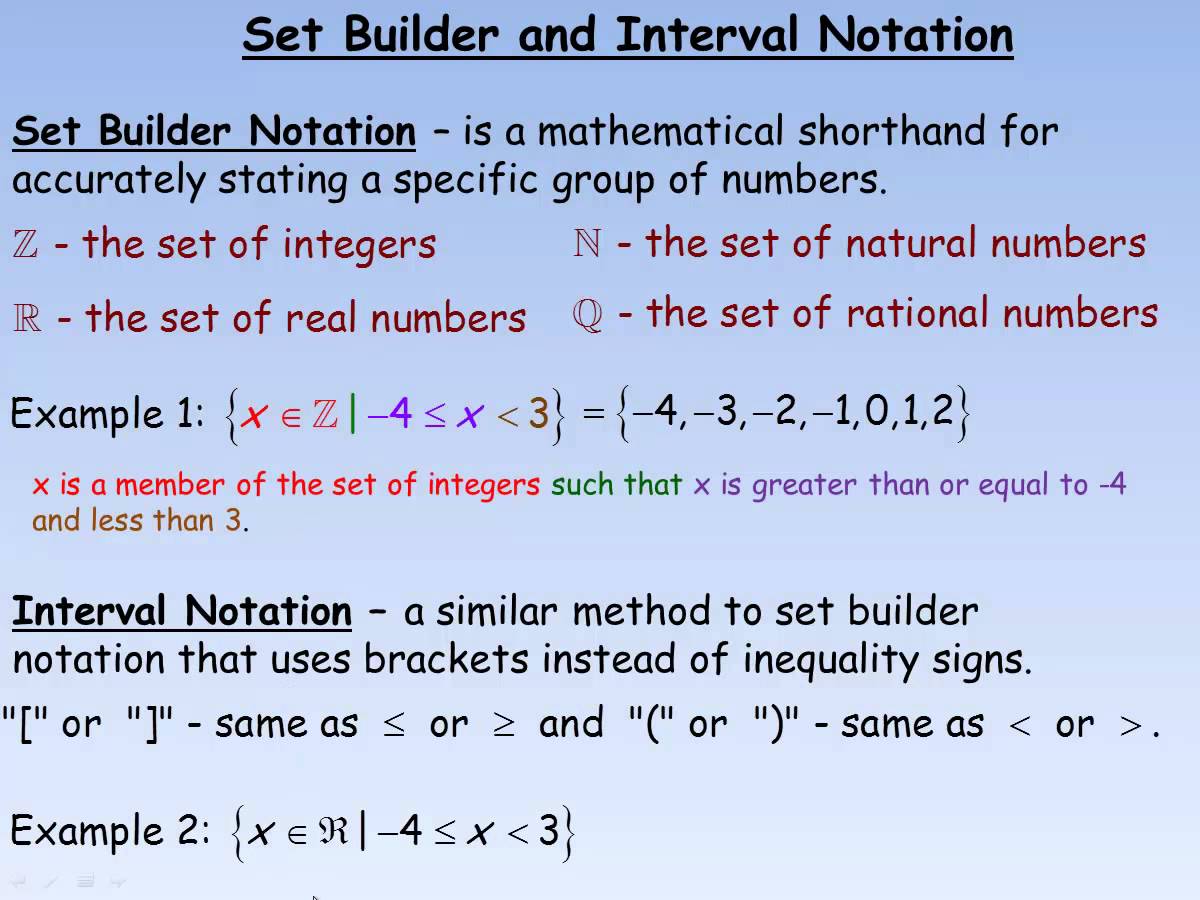Set-builder & Interval Notation
A set is a collection of unique elements. Elements in a set do not “repeat”.
Methods of Describing Sets:
Sets may be described in many ways: by roster, by set-builder notation, by interval notation, by graphing on a number line, and/or by Venn diagrams. For graphing on a number line, see Linear Inequalities. For Venn diagrams, see Working with Sets and Venn Diagrams.

By roster: A roster is a list of the elements in a set, separated by commas and surrounded by French curly braces. It must be curly braces when denoting a set.
Using a roster to describe a solution may be referred to as expressing the solution in “set notation”.
If the set contains “…”, it means that the elements continue (in that direction) under the same pattern. (“…” is called an ellipsis.)
A roster can contain any number of elements from no elements to an infinite number. It may be awkward to write a roster for large sets.
The elements in a set are usually listed in increasing order, but may be listed in any order. Elements are not repeated.
Examples of rosters:
- { } denotes the empty set. The empty set is also denoted with the ∅, and sometimes referred to as the null set.
- {3} is a set with one element, such as the solution to x + 5 = 8.
- {-5, 5} is a set with two elements, such as the solution to x2 = 25.
- {3, 4, 5, 6 7} is the set of integers from 3 to 7 inclusive.
- {… ,-1,0,1 2, 3, …} means the solution can be any integer value.
By set-builder notation:
Set-builder notation is a list of all of the elements in a set, separated by commas, and surrounded by French curly braces.
The symbol ” | ” is read as “such that”. It may also appear as ” : “, meaning “such that”.
The ∈ is read “is an element of “.
Set-builder notation is a mathematical shorthand for precisely stating all numbers of a specific set that possess a specific property. It may appear in a variety of forms, and may reference different number systems:

Examples of set-builder notation:
- {x | x > 0} Is read: “the set of all x’s, such that, x is greater than 0”.
- {x ∈ R | x ≤ 7} Is read: “the set of x’s, x being an element of the Real numbers, such that, x is less than or equal to 7”.
- {x ∈ Z | 3 < x ≤ 10} Is read: “the set of x’s, x being an element of the Integer numbers, such that, x is greater than 3 and less than or equal to 10”.
It is the set {4, 5, 6, 7, 8, 9, 10}.
By interval notation: An interval is a connected subset of numbers. Interval notation is an alternative to expressing your answer as an inequality. Unless specified otherwise, we will be working with real numbers.
In interval notation:
” ( ” means “not included” or “open”.
” [ ” means “included” or “closed”.
Infinity is always expressed as being “open”.
Examples of interval notation:
Inequality: -3 < x ≤ 8
In interval notation: (-3, 8]
Combinations of intervals:
x < 5 or x > 10 becomes (-∞,5) U (10,∞).
The word “or” has been replaced with the symbol “U” which stands for “union”, the joining of two sets.

Intervals
There are four types of interval:
- Open interval: Let a and b be two real numbers such that a<b, then the set of all real numbers lying strictly between a and b is called an open interval and is denoted by ]a, b[ or (a, b). Thus, ]a, b[ or (a, b)= { x ∈ R: a < x < b}.
- Closed interval: Let a and b be two real numbers such that a<b, then the set of all real numbers lying between a and b including a and b is called a closed interval and is denoted by [a, b]. Thus, [a, b] = { x ∈ R: a ≤ x ≤ b}.
- Open-Closed interval: It is denoted by ]a, b] or (a, b] and ]a, b] or (a, b] = { x ∈ R: a < x ≤ b}.
- Closed-Open interval: It is denoted by [a, b[ or [a, b) and [a, b[ or [a, b) = { x ∈ R: a ≤ x < b}.
The chart below will show you all of the possible ways of utilizing interval notation.

Note: The “Open-Interval” form may resemble an “ordered pair” used in graphing. The context of the question will tell you whether (1, 4) means “all numbers between 1 and 4” or “a point that is over 1, up 4 from the origin” on a graph.
If you see (-∞, 7] ∩ (3, ∞), you are looking for where the two sets overlap. The symbol combo5stands for “intersection”, which are those points that are in BOTH sets. This intersection is (3,7].